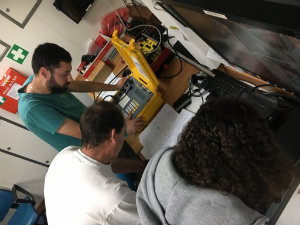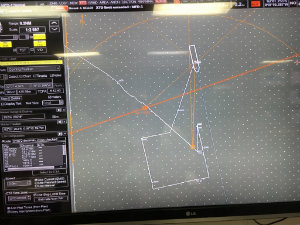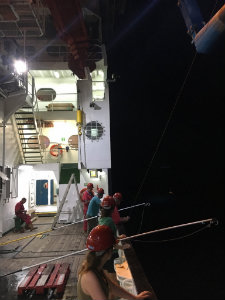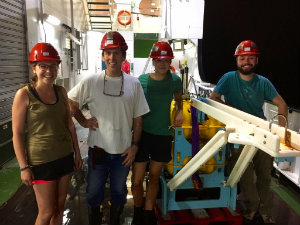 Sometimes things don’t always go as to plan. We arrived at site I04D at 15:00, quickly establishing communication with the OBMT and the OBS. The OBMT was on its way to the surface with an ETA of 17.50 – all was going well. After surveying in the location of the OBS and sending an acoustic signal for the instrument to release its anchor and start rising, things took a turn for the worse. The OBS showed no sign of rising. After waiting 3.5 hours for some sign of motion, we moved to Plan B.
Sometimes things don’t always go as to plan. We arrived at site I04D at 15:00, quickly establishing communication with the OBMT and the OBS. The OBMT was on its way to the surface with an ETA of 17.50 – all was going well. After surveying in the location of the OBS and sending an acoustic signal for the instrument to release its anchor and start rising, things took a turn for the worse. The OBS showed no sign of rising. After waiting 3.5 hours for some sign of motion, we moved to Plan B.
Because the instrument was responding to the acoustic  pinging, it could be located to within 25m. The ship positioned itself east of the instrument location and a 500kg anchor was attached to a winch with 7000m of cable. The weight descended nearly 4000m to the sea floor – after 75 minutes, a slight release in tension indicated that the weight had reached the seafloor. The ship then steamed at 0.2knots 200m south, 200m west, 200m north and 100m east, letting out another 1500m of cable. The ships route is the white line shown in the figure above. The whole process took over 3 hours. The idea was to drag the cable across the seafloor, hopefully nudging the OBS into motion. The plan seemed a
pinging, it could be located to within 25m. The ship positioned itself east of the instrument location and a 500kg anchor was attached to a winch with 7000m of cable. The weight descended nearly 4000m to the sea floor – after 75 minutes, a slight release in tension indicated that the weight had reached the seafloor. The ship then steamed at 0.2knots 200m south, 200m west, 200m north and 100m east, letting out another 1500m of cable. The ships route is the white line shown in the figure above. The whole process took over 3 hours. The idea was to drag the cable across the seafloor, hopefully nudging the OBS into motion. The plan seemed a  bit of a reach – literally – we were trying to lasso a 1m wide object that lay 4000m away with 5500m of rope.
bit of a reach – literally – we were trying to lasso a 1m wide object that lay 4000m away with 5500m of rope.
The winch was locked and the ship steamed northward at 0.2 knots. This sort of manoeuvre is a bit tense as the cable can snag on a rock outcrop and get stuck – the cable tension was monitored carefully. Throughout the process the OBS was monitored for any sign of motion. Some 30 minutes into the procedure, Simone cautiously muttered “I think it is rising”. It is always a bit difficult to confirm lift-off when the ship is moving, but eventually the depths were shallower than the water depth, and a sense of jubilation swept through the lab.
Some 90 minutes later the OBS arrived on deck, joyful and triumphant. By 2am the cable had been retrieved and we were en-route to the next station. The entire process had taken 11 hours, but another station – and more data – had arrived. A post-mortem revealed that the burn-wire had been removed, but the spring that holds the anchor had failed to release. The cable must have jostled the instrument enough to release it. Below is a picture of the relieved IPGP group and their instrument.
